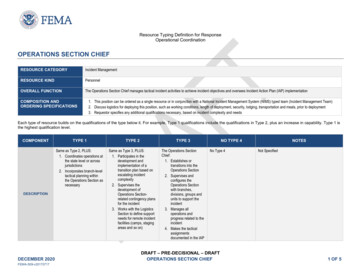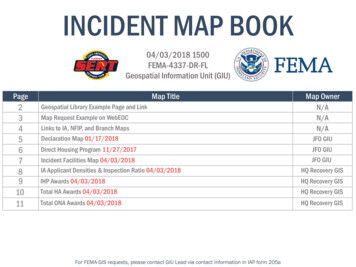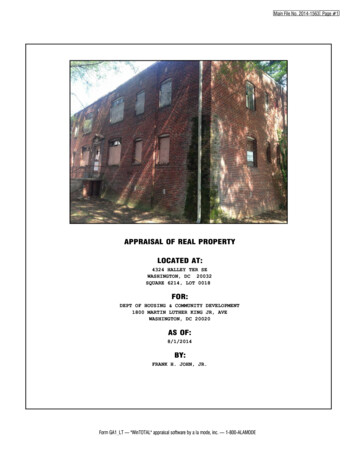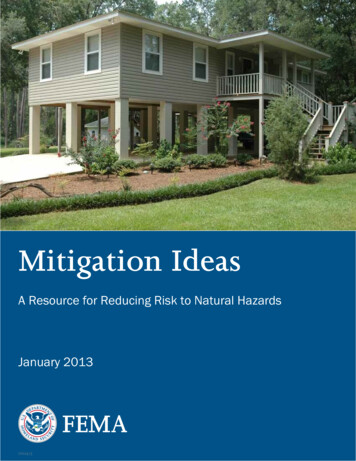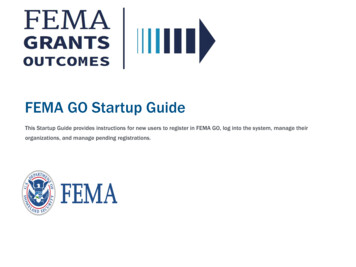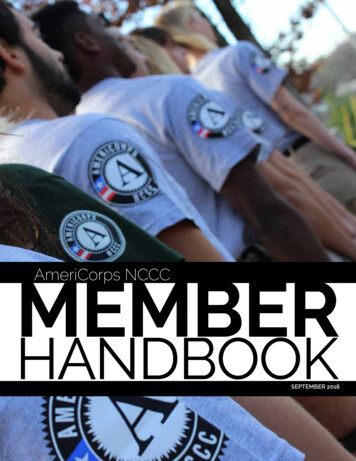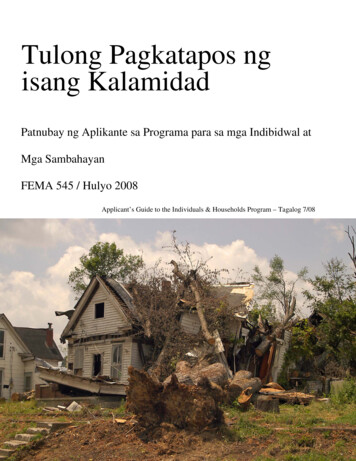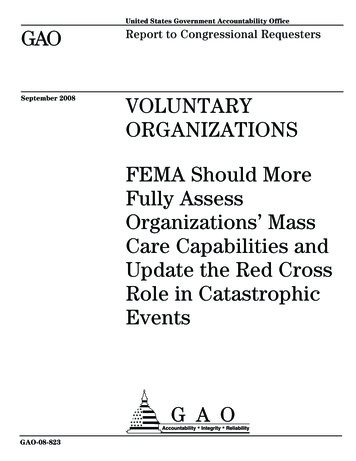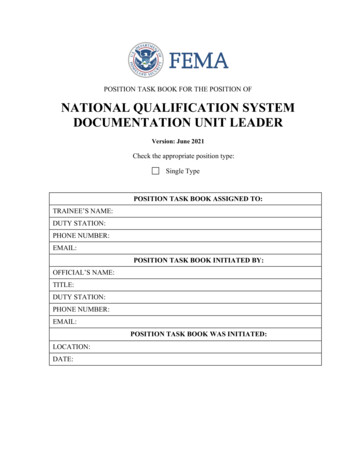
Transcription
POSITION TASK BOOK FOR THE POSITION OFNATIONAL QUALIFICATION SYSTEMDOCUMENTATION UNIT LEADERVersion: June 2021Check the appropriate position type:Single TypePOSITION TASK BOOK ASSIGNED TO:TRAINEE’S NAME:DUTY STATION:PHONE NUMBER:EMAIL:POSITION TASK BOOK INITIATED BY:OFFICIAL’S NAME:TITLE:DUTY STATION:PHONE NUMBER:EMAIL:POSITION TASK BOOK WAS INITIATED:LOCATION:DATE:
Evaluator Verification(Do not complete this form unless you are recommending the trainee for all-hazards certification.)FINAL EVALUATORVERIFICATIONI verify thathas successfully completed all tasks as a trainee and should therefore be considered for certification inthis position. I also verify that all tasks are documented with appropriate initials.FINAL EVALUATOR’S SIGNATURE:DATE:FINAL EVALUATOR’S PRINTED NAME:TITLE:DUTY STATION:PHONE NUMBER:EMAIL:Documentation of Agency CertificationDOCUMENTATION OFAGENCY CERTIFICATIONI certify thathas successfully met all of the criteria set out in the National Incident Management System (NIMS) JobTitle/Position Qualifications document for the position and will hereby receive certification of his/herqualification.OFFICIAL’S SIGNATURE:DATE:OFFICIAL’S NAME:TITLE:DUTY STATION:PHONE NUMBER:EMAIL:Version: June 2021
Position Task Book OverviewThe Position Task Book (PTB) documents the performance criteria a trainee must meet to be certifiedfor a position within the National Qualification System (NQS). The performance criteria are associatedwith core NQS competencies, behaviors and tasks.A trainee may not work on multiple position type PTBs for a specific position at the same time; forexample, a trainee may not simultaneously work on a Type 1 Incident Commander PTB and a Type 2Incident Commander PTB. If a position has multiple types, the trainee must, in most cases, qualify at thelowest type before pursuing the next higher type. For example, before seeking qualification for a Type 1position, an individual must first qualify at the Type 3 level and then at the Type 2 level.Evaluation Process Evaluators observe and review a trainee’s completion of PTB tasks, initialing and dating eachsuccessfully completed task in the PTB. Evaluators complete an Evaluation Record Form after each evaluation period by documentingthe trainee’s performance. The Authority Having Jurisdiction (AHJ) may not have enough resources to ensure that everyevaluator is qualified in the position being assessed. Therefore, a trainee’s supervisor mayevaluate the completion of PTB tasks. For example, a Logistics Section Chief has the authorityto sign off on completed PTB tasks for a Food Unit Leader trainee. The final evaluator is a leader who verifies that a trainee has completed the PTB and met allrequirements for the position. A final evaluator is generally qualified in the same position forwhich the trainee is applying. When possible, the evaluator and the final evaluator should not bethe same person, but in situations with limited resources, the evaluator can also serve as the finalevaluator. Once the final evaluator has completed the Final Evaluator Verification, he/she forwards it to theQualifications Review Board (QRB) along with supporting evidence that the trainee hascompleted all position requirements. After the QRB review, the AHJ completes the Documentation of Agency Certification form asappropriate.Transferring Qualifications Personnel who have documentation of previous education, training or significant on-the-jobincident experience may receive credit toward qualification for a given position. Each AHJestablishes the requirements for transferring qualifications from another AHJ. If an AHJ chooses not to accept a trainee’s existing certification of qualification, the trainee maybe reevaluated in the specific position and issued a new PTB. An individual may hold multiple certifications of qualification (that is, the Final EvaluatorVerification form and the Documentation of Agency Certification form) along with thecompleted PTB.Version: June 2021
Position Task Book Competencies, Behaviors and TasksThe PTB sets minimum criteria for certification for a position. The AHJ has the authority to add content tothe baseline PTB competencies, behaviors and tasks as necessary.The PTB covers all type levels for a given position, but an AHJ may check only one “Type” box andwork on only one type at a time. (The National Incident Management System (NIMS) Job Title/PositionQualifications document describes all types.)Command and General Staff job titles/positions qualifications are typed based on incident complexity,while all other NIMS positions are typed based on the minimum qualifications.DefinitionsCompetency: An observable, measurable pattern of knowledge, skills, abilities and othercharacteristics an individual needs to perform an activity and its associated tasks. A competencyspecifies the skillset a person needs to possess to complete the tasks successfully.Behavior: An observable work activity or a group of similar tasks necessary to perform the activity.Task: A specific, demonstrable action necessary for successful performance in a position. Trainees mustdemonstrate completion of required tasks. Occasionally, PTB tasks are unique to one of the types; for example, certain tasks apply only to aType 3 Incident Commander, not to a Type 2 or Type 1 Incident Commander. In those cases, thePTB indicates the corresponding type at the beginning of the task.All tasks require evaluation. Bullet statements within a task are only examples and do not need to beperformed to have a task signed off.PTB Task CodesFor each of the tasks listed in the Position Task Book (PTB), there are one or more codes describingthe circumstances in which the trainee can perform tasks related to the position. If a task has multiplecodes listed, it means the evaluator can assess the trainee on any of those circumstances as opposed toevaluating the trainee on all of the listed codes.Code C: Task performed in training or classroom setting, including seminars and workshops.Code E: Task performed on a full-scale exercise with equipment deployment under the IncidentCommand System (ICS).Code F: Task performed during a functional exercise managed under the ICS.Code I: Task performed on an incident or event managed under ICS. Examples of incidents and eventsthat may employ ICS include but are not limited to an oil spill, search and rescue, hazardous materialresponse, fire and emergency or non-emergency (planned or unplanned) events.Code J: Task performed as part of day-to-day job duties.Code T: Task performed during a tabletop exercise.Code R: Task performed very rarely and required only if applicable to the event. Note: Assignment of CodeR is not recommended. However, AHJs may add at their discretion to tasks added to NQS PTBs.Version: June 2021
How to Complete the Evaluation Record FormEach Evaluation Record Form (see next page) covers one evaluation period. Evaluation periods mayinvolve incidents, classroom simulations or daily duties, depending on what the PTB recommends. TheAHJ determines the number of evaluations required for position qualification and certification. Ifevaluators need additional evaluation periods, they can copy pages from a blank PTB and attach them tothe PTB in question.Complete these items AT THE START of the evaluation period:Evaluation Record Number: Label each evaluation record with a number to identify the incident(s),exercise(s) or event(s) during which the trainee completed the PTB tasks. The evaluator should alsowrite this number in the PTB column labeled “Evaluation Record #” for each task performedsatisfactorily. This number enables reviewers of the completed PTB to ascertain the evaluators’qualifications before signing off on the PTB.Evaluator’s name; Incident/office title and agency: List the name of the evaluator, his/herincident position or office title and the evaluator’s home agency.Evaluator’s home jurisdiction address and phone: List evaluator’s home jurisdiction address and phonenumber.Name and location of incident or simulation/exercise: Identify the name (if applicable) and locationwhere the trainee performed the tasks.Incident kind: Enter the kind of incident (such as hazmat, law enforcement, wildland fire, structuralfire, search and rescue, flood or tornado).Complete these items AT THE END of the evaluation period:Number and kind of resources: Enter the number of resources assigned to the incident and theirkind (such as team, personnel and equipment) pertinent to the trainee’s PTB.Evaluation period: Enter inclusive dates of trainee evaluation. This time span may cover severalsmall, similar incidents.Position type: Enter position type (such as Type 3, Type 2, Type 1 or Single Type).Recommendation: Check the appropriate line and make comments below regarding the trainee’sfuture development needs.Additional recommendations/comments: Provide additional recommendations and comments abouttrainee, as necessary.Date: List the current date.Evaluator’s initials: Initial here to authenticate your recommendations and to allow for comparisonwith initials in the PTB.Evaluator’s relevant qualification: List your certification relevant to the trainee position yousupervised.Version: June 2021
Evaluation Record FormTRAINEE NAME:TRAINEE POSITION:Evaluation Record Number:Evaluator’s name:Incident/office title and agency:Evaluator’s home jurisdiction address and phone:Name and location of incident or simulation/exercise:Incident kind:Number and kind of resources:Evaluation period:Position type:Recommendation:The above named trainee performed the initialed and dated tasks under my supervision. I recommend thefollowing for this trainee’s further development:The trainee has successfully performed all required tasks for the position. The AHJ should consider theindividual for certification.The trainee could not complete certain tasks or needs additional guidance. See comments below.Not all tasks were evaluated on this assignment. An additional assignment is needed to complete theevaluation.The trainee is severely deficient in the performance of tasks and needs further training prior toadditional assignment(s) as a trainee for this position.Additional recommendations/comments:Date:Evaluator’s initials:Evaluator’s relevant qualification:Version: June 2021
Position Task Book: Documentation Unit LeaderDocumentation Unit Leader1. Competency: Assume position responsibilitiesDescription: Successfully assume the role of Documentation Unit Leader and initiate position activities at theappropriate time according to the following behaviors.1a. Behavior: Ensure readiness for assignmentTASK1.2.3.Obtain, assemble and prepare information and materialsfor go-kit. The kit should contain critical items for theassignment and be easily transportable: Supplies:o Office supplies appropriate to the functiono Authority Having Jurisdiction (AHJ) identificationbadge and qualification card Reference materials:o Functional guidelines relative to incident type(agency guidance or other functional guidelines)o AHJ operations guides or other operational guideso Position manuals Forms:o Agency-specific forms appropriate to the functionObtain complete incident and logistical information: Incident name, number, anticipated duration, size,type, responsibilities and expectations Reporting time and location Transportation arrangements and travel routes Contact procedures during travel (telephone/radio) Expected working conditions Personal Protective Equipment (PPE) Security measures Updated contact information and information linksArrive properly equipped at designated time and locationand check in according to agency/organizationguidelines: Arrive with go-kit and any additional equipment Carry out check-in procedures and ensure assignedpersonnel do the sameVersion: June 2021CODEE, F, IEVALUATIONRECORD #EVALUATORINITIALS ANDDATEE, F, IE, F, I7 Page
Position Task Book: Documentation Unit Leader1b. Behavior: Obtain information relevant to position assignmentTASK4.5.Receive briefing from the Planning Section Chief or theoutgoing Documentation Unit Leader: Meetings and briefings schedule Situational assessment Incident objectives Strategy Hazards to incident personnel and public Agencies/jurisdictions involved Organizational structure Resources summary Logistical needs Ordering procedures Incident priorities and status: life safety, incidentstabilization, property and environment Timing and scheduling Expected productsObtain and review necessary documentation: Copy of Delegation of Authority, Letter ofExpectation, Letter of Agreement or Memorandum ofUnderstanding (MOU) Applicable plans and reports Directories: phone, notification Written incident status summary Authorizations: cell phones, rental vehicles, computersCODEEVALUATIONRECORD #E, F, IEVALUATORINITIALS ANDDATEE, F, I1c. Behavior: Establish or determine organizational structure, resource and staffing needsTASK6.7.Evaluate staffing needs required to manage the unit: Ensure consistency with National IncidentManagement System (NIMS) organizational structure Identify training opportunities Ensure use of established procedures for orderingresources Request appropriate technical specialists to assist withspecial incident conditionsUtilize unit personnel: Establish appropriate organization and assign rolesand responsibilities, while maintaining span of controlVersion: June 2021CODEE, F, IEVALUATIONRECORD #EVALUATORINITIALS ANDDATEE, F, I8 Page
Position Task Book: Documentation Unit Leader2. Competency: Lead assigned personnelDescription: Influence, lead and direct assigned personnel to accomplish objectives and desired outcomesin a potentially rapidly changing environment.2a. Behavior: Model leadership values and principlesTASK8.Understand and comply with NIMS/Incident CommandSystem (ICS) concepts and principles: Establish and modify an effective organization basedon changing incident and resource conditions Maintain appropriate span of control Act as a representative of incident leadership9. Create a positive work environment: Communicate leader’s intent and guidance Manage unit and its activities effectively Proactively assume responsibility for the unit andinitiate action10. Exhibit principles of duty, respect and integrity as aleader.11. Establish and maintain positive interpersonal andinteragency working relationships: Understand scope, roles, responsibilities, jurisdictionand authority of responding agenciesCODEEVALUATIONRECORD #E, F, IEVALUATORINITIALS ANDDATEE, F, IC, E, F,I, J, TE, F, I2b. Behavior: Communicate incident priorities and supervise personnelTASKCODE12. Communicate with assigned personnel: Communicate priorities, objectives, strategies and anychanges Inform personnel of their assigned tasks andexpectations Clearly explain conflict resolution procedures andensure that personnel understand Ensure that assigned objectives and expectations forthe operational period are reasonable and accurate13. Ensure that staff follows all applicableagency/jurisdiction policies, contracts, standard operatingprocedures and agreements: Federal, state, local, tribal, territorial and regionalrelationships, as appropriate Roles and responsibilities of potential responderagencies Scope, jurisdiction and authority of potential responderagencies’ contingency plansE, F, IVersion: June 2021EVALUATIONRECORD #EVALUATORINITIALS ANDDATEE, F, I9 Page
Position Task Book: Documentation Unit LeaderTASK14. Supervise and hold personnel accountable for executingassigned tasks: Identify and promptly resolve disagreements, issuesand misunderstandings Prioritize work while considering immediate supportfor incident operations15. Ensure debriefings occur and participate as necessary: Ensure incident situation status information is currentand completeCODEEVALUATIONRECORD #E, F, IEVALUATORINITIALS ANDDATEE, F, I2c. Behavior: Ensure the health, safety, welfare and accountability of assigned personnelTASKCODE16. Evaluate mental and physical fatigue of assignedpersonnel: Ensure adequate rest is provided to section personnel17. Recognize potentially hazardous situations, informassigned personnel of hazards and take precautions tomitigate risk: Adjust operations in response to hazards, weather andother relevant events18. Demonstrate knowledge of and comply with relevanthealth and safety requirements: Direct and oversee unit operations to ensurecompliance with health and safety considerations andguidelines Coordinate with the Safety Officer to ensure thatassigned personnel follow safety guidelines19. Report or explain the procedures for reportingunexpected occurrences, such as fire, death, injury,illness, exposure to pathogens or hazardous materials(HAZMAT), accident, political contact or property lossor damage: Ensure report contains nature of event, location,magnitude, personnel involved and initial action taken(such as helicopter picking up injured or anappropriate subsequent action) Ensure the protection of Personally IdentifiableInformation (PII) while reporting Obtain information from the following sourcesregarding special hazards, threats or unexpectedoccurrences: subordinates, personal observation, otherincident personnel and off-incident personnelE, F, IVersion: June 2021EVALUATIONRECORD #EVALUATORINITIALS ANDDATEE, F, IE, F, IE, F, I10 P a g e
Position Task Book: Documentation Unit Leader2d. Behavior: Identify opportunities and meet requirements to provide equal access andreasonable accommodation in all activitiesTASKCODE20. Demonstrate the ability to identify opportunities foruniversal accessibility.E, F, I, J21. Demonstrate the ability to assess and monitor forphysical access, programmatic access and effectivecommunications access.22. Provide equal access, disability accommodations andaccess and functional needs (AFN) accommodations.E, F, I, JVersion: June 2021EVALUATIONRECORD #EVALUATORINITIALS ANDDATEE, F, I, J11 P a g e
Position Task Book: Documentation Unit Leader3. Competency: Conduct operations and ensure completion of assigned tasksDescription: Identify, analyze and apply relevant situational information and evaluate actions to completeassignments safely and meet identified objectives. Complete actions within established time frame.3a. Behavior: Set the unit prioritiesTASKCODE23. Attend and participate in strategy meetings as necessary: Assess organizational needs Identify additional resource needs Identify critical factors to ensure unit success Prioritize incident, section and unit objectives24. Disseminate priorities and expected completion timelinesto staff.E, F, I25. Analyze work assignments and staffing levels to ensureachievement of unit objectives.E, F, I26. Hold staff accountable for communicated priorities anddeadlines.E, F, IEVALUATIONRECORD #EVALUATORINITIALS ANDDATEEVALUATIONRECORD #EVALUATORINITIALS ANDDATEE, F, I3b. Behavior: Develop and implement plansTASK27. Participate in the planning process: Prepare for and participate in planning meetings Assist in the development of plans, as necessary:o Long-rangeo Strategico Contingencyo Demobilizationo Continuity of Operations Plan (COOP)28. Review, validate and modify plans: Analyze alternate strategies and explain decisions Validate or revise unit objectives Review information covering health and safetyprinciples, known hazards and importance of allperiods Validate unit organizational structure Validate unit resource assignments Review reserve resources Evaluate immediate support needs29. Approve completed plans: Ensure plans are complete, accurate, realisticallyattainable and relevant to the incident objectivesVersion: June 2021CODEE, F, IE, F, IE, F, I12 P a g e
Position Task Book: Documentation Unit Leader3c. Behavior: Coordinate with all appropriate personnel and stakeholdersTASKCODE30. Establish effective relationships with stakeholders andpartners in the impacted jurisdiction(s).E, F, I31. Establish effective relationships and coordinate withincident personnel: IMT personnel Other supporting personnelE, F, IEVALUATIONRECORD #EVALUATORINITIALS ANDDATEEVALUATIONRECORD #EVALUATORINITIALS ANDDATEEVALUATIONRECORD #EVALUATORINITIALS ANDDATE3d. Behavior: Apply agency policy, contracts and agreementsTASKCODE32. Demonstrate knowledge of and apply relevant legal,regulatory and fiscal constraints.E, F, I33. Complete all work according to organization/agencydirection, policy and incident objectives: Ensure that personnel complete all documentationrequirements according to organization/agencydirection, policy and incident objectivesE, F, I3e. Behavior: Ensure documentation is completeTASKCODE34. Review documents for accuracy, timeliness andappropriate distribution.E, F, I35. Maintain and collect personal records related to incident: Time sheets Rental records Accident forms Property recordso Equipment time records Receipts36. Maintain and submit incident records for events,personnel, equipment, supplies and other data forincident management needs: Property loss/damage reports Agency-required incident reports Activity log Changes in strategy and tactics37. Establish priorities for document duplication inconjunction with Planning Section time frames: Ensure existence of contingency plans for backupduplication servicesE, F, IVersion: June 2021E, F, IE, F, I13 P a g e
Position Task Book: Documentation Unit LeaderTASKCODE38. Review documentation for completeness and implementprocedure to resolve inconsistencies: Consult with document author Bring to attention of appropriate section chief, branchdirector, group supervisor or unit leader39. Ensure the protection of PII.E, F, I40. Ensure that all personnel who handle data or intelligenceare aware of and maintain a document security plan tomanage the confidentiality and security of any classified,confidential, sensitive and For Official Use Only (FOUO)documentation, intelligence, data or incident informationE, F, IEVALUATIONRECORD #EVALUATORINITIALS ANDDATEEVALUATIONRECORD #EVALUATORINITIALS ANDDATEE, F, I3f. Behavior: Provide duplication and documentation servicesTASKCODE41. Provide document duplication and collation services: Consider alternative document duplication services,such as on-incident or off-incident contract services Anticipate and plan for future document duplicationneeds42. Develop or administer system for managing documentduplication requests: General message File box Electronic task request via emergency managementsoftware43. Provide for duplication and distribution of IncidentAction Plan (IAP) and other relevant plans: Determine number of copies necessary in consultationwith the appropriate section chief Produce and distribute copies within established timeframe44. Produce final documentation package: Include appropriate files from sections, branches,groups and units Determine recipients for final documentation package Provide package to Planning Section Chief for finalreview and approval Complete index for final documentation package45. Ensure that duplication equipment is operational.E, F, I, J46. Ensure availability of and access to secure storage.Version: June 2021E, F, IE, F, IE, F, IE, F, IE, F, I14 P a g e
Position Task Book: Documentation Unit Leader3g. Behavior: Create and maintain an incident records management systemTASKCODE47. Function as the file custodian for incident records anddocuments: IAP Situation reports Activity logs Chronologies Resource request forms48. Set up process for document collection: File box Mailbox Digital method49. Establish filing system for documentation: Index files Digital files50. Mark, secure and store all sensitive records anddocuments in a secure manner: Secure storage: locked file cabinet or room Mark designation, if appropriate51. Maintain control of and access to all incident-related filesand records.E, F, I52. Produce a backup method for files as appropriate: Emergency management software Hard copies Digital backup53. Maintain a set of easily portable critical files (mostly inelectronic format) for rapid evacuation, in accordancewith COOP planning.54. Ensure the transfer of final documentation package forthe AHJ, as appropriate: Maintain chain of custody for all records anddocuments at closeout Archive according to AHJ protocolsE, F, IVersion: June 2021EVALUATIONRECORD #EVALUATORINITIALS ANDDATEE, F, IE, F, IE, F, IE, F, IE, F, IE, F, I15 P a g e
Position Task Book: Documentation Unit Leader4. Competency: Communicate effectivelyDescription: Use suitable communication techniques to share relevant information with appropriatepersonnel on a timely basis to accomplish objectives in a potentially rapidly changing environment.4a. Behavior: Ensure the exchange of relevant information during briefingsTASK55. Prepare for and participate in briefings: Ensure briefings are accurate, timely and includeappropriate personnel Brief external support organizations Share and evaluate information 56. Lead staff briefings and debriefings.Version: June 2021CODEE, F, IEVALUATIONRECORD #EVALUATORINITIALS ANDDATEE, F, I16 P a g e
Position Task Book: Documentation Unit Leader5. Competency: Prepare for demobilization/transferDescription: Demobilize position and transfer position duties.5a. Behavior: Transfer position duties while ensuring continuityTASKCODE57. Complete the process for demobilizing positionresponsibilities: Brief and provide complete and accurate records torelief personnel Discuss equipment release considerations Coordinate with appropriate partners regardingdemobilization procedures Brief personnel on demobilization responsibilities Ensure personnel demobilize in a timely and completemanner Emphasize safety and accountability during this phaseof operations58. Coordinate an efficient transfer of position duties whendeactivating or demobilizing resources: Inform assigned personnel Notify incoming personnel when and where transitionof positions will occur Conduct transition effectively Document follow-up action and submit to agencyrepresentative59. Complete all necessary reports and narratives followingcommon standards before turnover: Activity log Shift change End of operational period Reassignment Deactivation/demobilization60. Participate in transition or incident closeout: Conduct debriefings with agency administrator(s) asrequested Close out incident as appropriate for the AHJC, E, F,I, J, TEVALUATIONRECORD #EVALUATORINITIALS ANDDATEE, F, IE, F, IE, F, I5b. Behavior: Plan for demobilization and ensure staff follow demobilization processTASK61. Participate in the development, approval andimplementation of the demobilization plan: Coordinate with appropriate partners regardingdemobilization procedures Coordinate needs and responsibilitiesVersion: June 2021CODEE, F, IEVALUATIONRECORD #EVALUATORINITIALS ANDDATE17 P a g e
Position Task Book: Documentation Unit LeaderTASK62. Provide incident documentation in support of AfterAction Review (AAR) process.Version: June 2021CODEE, F, IEVALUATIONRECORD #EVALUATORINITIALS ANDDATE18 P a g e
with core NQS competencies, behaviors and tasks. A trainee may not work on multiple position type PTBs for a specific position at the same time; for . The final evaluator is a leader who verifies that a trainee has completed the PTB and met all requirements for the position. A final evaluator is generally qualified in the same position for
